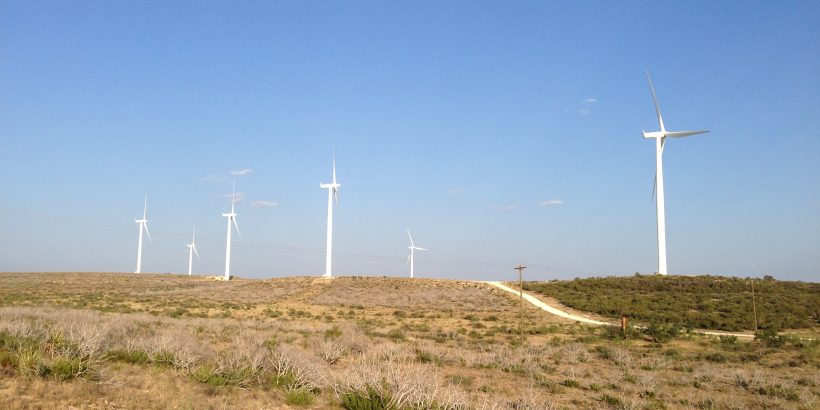Green Mountain Energy® Blog
The Future of Wind Energy: 4 Things You Need to Know



Why is wind energy important for the future? By capturing the inexhaustible, renewable power of the wind, we have a cleaner way to power our homes and lives. That’s a win for the planet and all of its inhabitants.
And good news! The future of wind energy is here and now.
Wind energy is created using wind turbines, traditionally consisting of three blades that spin by the force of the wind. The turbine’s generator converts that mechanical energy into electricity, which is sent through transmission lines to the electricity grid and delivered to homes and businesses.
The U.S. Department of Energy (DOE) projects the country to have 404 gigawatts (GW) of wind energy capacity by 2050. That’s enough to fulfill more than one third of the nation’s electricity needs, if demand continues to hold steadily as estimated.
With growing consumer demand for clean, renewable energy and the future of wind energy technology looking strong, here are four things you need to know about the growth and impact of wind energy.
1. Wind turbines expand to more locations
Wind energy development continues to spread in new ways and to new places to meet the energy needs of people around the world. The WindFloat Atlantic Project, a 25-megawatt (MW) wind energy system off the shores of Portugal, will soon join Hywind Scotland’s five-turbine, 30-MW project as one of only two floating wind farms in the world. This type of offshore wind farm positions the turbines further from the coastline, where consistently stronger winds blow. Floating chains tether each turbine to the bottom of the sea—a more cost-efficient and less dangerous method than bottom-fixed offshore wind farms. Only three months after deployment in 2017, Hywind Scotland surpassed performance expectations, operating at 65% of its maximum capacity.
Fun fact: Hywind Scotland’s turbines stand 574 feet above water. If they stood side by side, they would dwarf Big Ben (315 feet), the Statue of Liberty (305 feet) and the Leaning Tower of Pisa (186 feet)!
But not all wind turbines are going bigger. At the opposite end of the spectrum, small-scale wind turbines are now readily available for residential use.
2. Adapting technology to harness the wind’s power
Wind energy technology is adapting and refining to become more efficient and economical. One example of this: high-altitude devices, which take advantage of the more powerful and more consistent winds at higher altitudes. This class of emerging wind-harnessing technology, also called Airborne Wind Energy Systems (AWES), includes airborne wind turbines like energy kites from Makani Power Inc.
AWES technology eliminates the need for the foundations and towers of conventional wind turbines, as well as their associated materials and maintenance costs. It also offers more options for wind power generation sites, both onshore and offshore.
Another interesting development: turbines without blades! Yep—companies like Vortex Bladeless seek to minimize construction and maintenance costs as well as environmental impact with a sleek and compact bladeless turbine design.
With wind power innovation rapidly advancing, the sky may not be the limit after all!
3. Oil producers are now turning to offshore wind farms
Faced by pressure from shareholders to develop its renewable business, Shell has joined other oil companies wanting to leverage their similar supply chains and experience drilling at sea. Termed a technological arms race by The Wall Street Journal, this sprint to build wind farms economically and profitably is so competitive that many companies won’t even disclose how much they are investing.
With oil and gas companies entering the offshore wind game, large-scale projects could generate more wind power in the United States as well as bring energy generation costs down and create more jobs.
4. More investment and confidence in wind energy
At 23,262 MW and counting, Texas leads the nation in installed wind power capacity.
As the wind industry shows more viability and growth, more investments have been pouring in to meet the sector’s growing needs. Recently, New York committed $27.5 million to training related to clean energy’s growing job opportunities.
Fun fact: According to the U.S. Bureau of Labor Statistics, wind turbine service technician is projected to be the second-fastest-growing occupation from 2016 to 2026 (behind solar photovoltaic installers).
Other innovations involve increasing the efficiency of turbine drivetrains, which actually generate electricity from the spinning blades. In 2017, MHI Vestas announced it would invest $35 million for Clemson University to test its new 9.5-MW gearbox at the university’s Energy Innovation Center. The turbine would be the most powerful wind turbine in the world.
In summary, wind energy technology is expanding, adapting, refining, finding more support from various investors and experiencing overall growth. The future of wind energy in the U.S. and abroad is looking brighter than ever.
Find a renewable energy plan that helps your home go green.
Enter your ZIP code to get started.
Our customers have avoided
pounds of CO2
That’s like planting
new trees.





